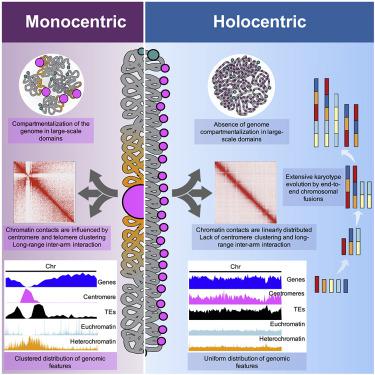Cell ( IF 64.5 ) Pub Date : 2022-08-03 , DOI: 10.1016/j.cell.2022.06.045 Paulo G Hofstatter 1 , Gokilavani Thangavel 1 , Thomas Lux 2 , Pavel Neumann 3 , Tihana Vondrak 4 , Petr Novak 3 , Meng Zhang 1 , Lucas Costa 5 , Marco Castellani 1 , Alison Scott 1 , Helena Toegelová 6 , Joerg Fuchs 7 , Yennifer Mata-Sucre 5 , Yhanndra Dias 5 , André L L Vanzela 8 , Bruno Huettel 9 , Cicero C S Almeida 10 , Hana Šimková 6 , Gustavo Souza 5 , Andrea Pedrosa-Harand 5 , Jiri Macas 3 , Klaus F X Mayer 11 , Andreas Houben 7 , André Marques 1

|
The centromere represents a single region in most eukaryotic chromosomes. However, several plant and animal lineages assemble holocentromeres along the entire chromosome length. Here, we compare genome organization and evolution as a function of centromere type by assembling chromosome-scale holocentric genomes with repeat-based holocentromeres from three beak-sedge (Rhynchospora pubera, R. breviuscula, and R. tenuis) and their closest monocentric relative, Juncus effusus. We demonstrate that transition to holocentricity affected 3D genome architecture by redefining genomic compartments, while distributing centromere function to thousands of repeat-based centromere units genome-wide. We uncover a complex genome organization in R. pubera that hides its unexpected octoploidy and describe a marked reduction in chromosome number for R. tenuis, which has only two chromosomes. We show that chromosome fusions, facilitated by repeat-based holocentromeres, promoted karyotype evolution and diploidization. Our study thus sheds light on several important aspects of genome architecture and evolution influenced by centromere organization.
中文翻译:

基于重复的全着丝粒影响基因组结构和核型进化
着丝粒代表大多数真核染色体中的单个区域。然而,一些植物和动物谱系沿整个染色体长度组装全着丝粒。在这里,我们通过将染色体规模的全心基因组与来自三种喙莎草( Rhynchospora pubera、R. breviuscula和R. tenuis)及其最接近的单中心亲缘的基于重复的全着丝粒组装,来比较基因组组织和进化作为着丝粒类型的函数。灯心草。我们通过重新定义基因组区室,同时将着丝粒功能分布到基因组范围内数千个基于重复的着丝粒单位,证明向全心性的转变影响了 3D 基因组结构。我们发现了一个复杂的基因组组织R. pubera隐藏了它意想不到的八倍体,并描述了R. tenuis的染色体数量显着减少,它只有两条染色体。我们表明,由基于重复的全着丝粒促进的染色体融合促进了核型进化和二倍体化。因此,我们的研究揭示了受着丝粒组织影响的基因组结构和进化的几个重要方面。



























 京公网安备 11010802027423号
京公网安备 11010802027423号